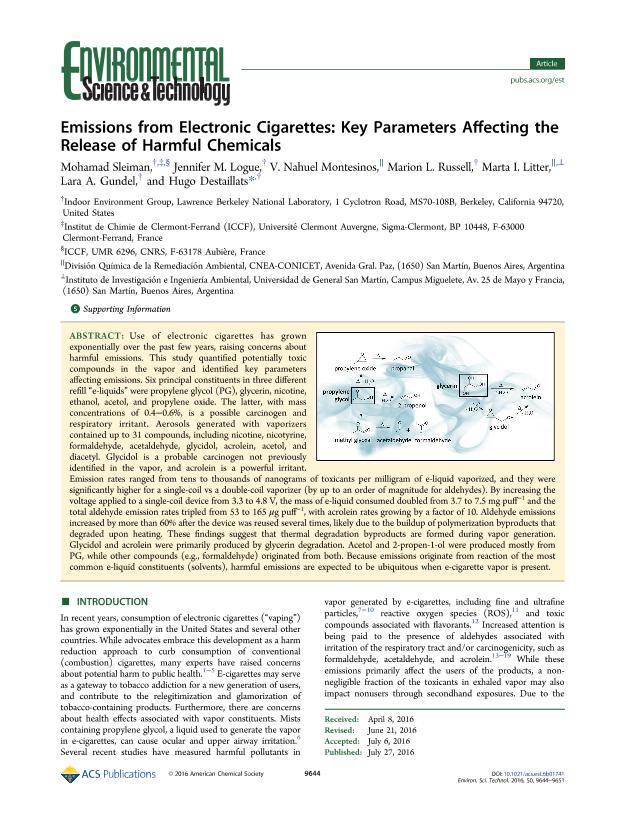Mostrar el registro sencillo del ítem
dc.contributor.author
Sleiman, Mohamad
dc.contributor.author
Logue, Jennifer M.
dc.contributor.author
Montesinos, Victor Nahuel

dc.contributor.author
Russell, Marion L.
dc.contributor.author
Litter, Marta Irene

dc.contributor.author
Gundel, Lara A.
dc.contributor.author
Destaillats, Hugo

dc.date.available
2020-05-21T17:38:03Z
dc.date.issued
2016-07
dc.identifier.citation
Sleiman, Mohamad; Logue, Jennifer M.; Montesinos, Victor Nahuel; Russell, Marion L.; Litter, Marta Irene; et al.; Emissions from Electronic Cigarettes: Key Parameters Affecting the Release of Harmful Chemicals; American Chemical Society; Environmental Science & Technology; 50; 17; 7-2016; 9644-9651
dc.identifier.issn
0013-936X
dc.identifier.uri
http://hdl.handle.net/11336/105702
dc.description.abstract
Use of electronic cigarettes has grown exponentially over the past few years, raising concerns about harmful emissions. This study quantified potentially toxic compounds in the vapor and identified key parameters affecting emissions. Six principal constituents in three different refill “e-liquids” were propylene glycol (PG), glycerin, nicotine, ethanol, acetol, and propylene oxide. The latter, with mass concentrations of 0.4–0.6%, is a possible carcinogen and respiratory irritant. Aerosols generated with vaporizers contained up to 31 compounds, including nicotine, nicotyrine, formaldehyde, acetaldehyde, glycidol, acrolein, acetol, and diacetyl. Glycidol is a probable carcinogen not previously identified in the vapor, and acrolein is a powerful irritant. Emission rates ranged from tens to thousands of nanograms of toxicants per milligram of e-liquid vaporized, and they were significantly higher for a single-coil vs a double-coil vaporizer (by up to an order of magnitude for aldehydes). By increasing the voltage applied to a single-coil device from 3.3 to 4.8 V, the mass of e-liquid consumed doubled from 3.7 to 7.5 mg puff–1 and the total aldehyde emission rates tripled from 53 to 165 μg puff–1, with acrolein rates growing by a factor of 10. Aldehyde emissions increased by more than 60% after the device was reused several times, likely due to the buildup of polymerization byproducts that degraded upon heating. These findings suggest that thermal degradation byproducts are formed during vapor generation. Glycidol and acrolein were primarily produced by glycerin degradation. Acetol and 2-propen-1-ol were produced mostly from PG, while other compounds (e.g., formaldehyde) originated from both. Because emissions originate from reaction of the most common e-liquid constituents (solvents), harmful emissions are expected to be ubiquitous when e-cigarette vapor is present.
dc.format
application/pdf
dc.language.iso
eng
dc.publisher
American Chemical Society

dc.rights
info:eu-repo/semantics/openAccess
dc.rights.uri
https://creativecommons.org/licenses/by-nc-sa/2.5/ar/
dc.subject
electronic cigarettes
dc.subject.classification
Físico-Química, Ciencia de los Polímeros, Electroquímica

dc.subject.classification
Ciencias Químicas

dc.subject.classification
CIENCIAS NATURALES Y EXACTAS

dc.title
Emissions from Electronic Cigarettes: Key Parameters Affecting the Release of Harmful Chemicals
dc.type
info:eu-repo/semantics/article
dc.type
info:ar-repo/semantics/artículo
dc.type
info:eu-repo/semantics/publishedVersion
dc.date.updated
2020-05-20T14:31:27Z
dc.journal.volume
50
dc.journal.number
17
dc.journal.pagination
9644-9651
dc.journal.pais
Estados Unidos

dc.description.fil
Fil: Sleiman, Mohamad. Université Clermont Auvergne; Francia. Lawrence Berkeley National Laboratory; Estados Unidos
dc.description.fil
Fil: Logue, Jennifer M.. Lawrence Berkeley National Laboratory; Estados Unidos
dc.description.fil
Fil: Montesinos, Victor Nahuel. Consejo Nacional de Investigaciones Científicas y Técnicas; Argentina. Comisión Nacional de Energía Atómica. Gerencia Química. CAC; Argentina
dc.description.fil
Fil: Russell, Marion L.. Lawrence Berkeley National Laboratory; Estados Unidos
dc.description.fil
Fil: Litter, Marta Irene. Universidad Nacional de San Martín. Instituto de Investigación en Ingeniería Ambiental; Argentina. Comisión Nacional de Energía Atómica. Gerencia Química. CAC; Argentina. Consejo Nacional de Investigaciones Científicas y Técnicas; Argentina
dc.description.fil
Fil: Gundel, Lara A.. Lawrence Berkeley National Laboratory; Estados Unidos
dc.description.fil
Fil: Destaillats, Hugo. Lawrence Berkeley National Laboratory; Estados Unidos
dc.journal.title
Environmental Science & Technology

dc.relation.alternativeid
info:eu-repo/semantics/altIdentifier/doi/http://dx.doi.org/10.1021/acs.est.6b01741
dc.relation.alternativeid
info:eu-repo/semantics/altIdentifier/url/https://pubs.acs.org/doi/10.1021/acs.est.6b01741
Archivos asociados
